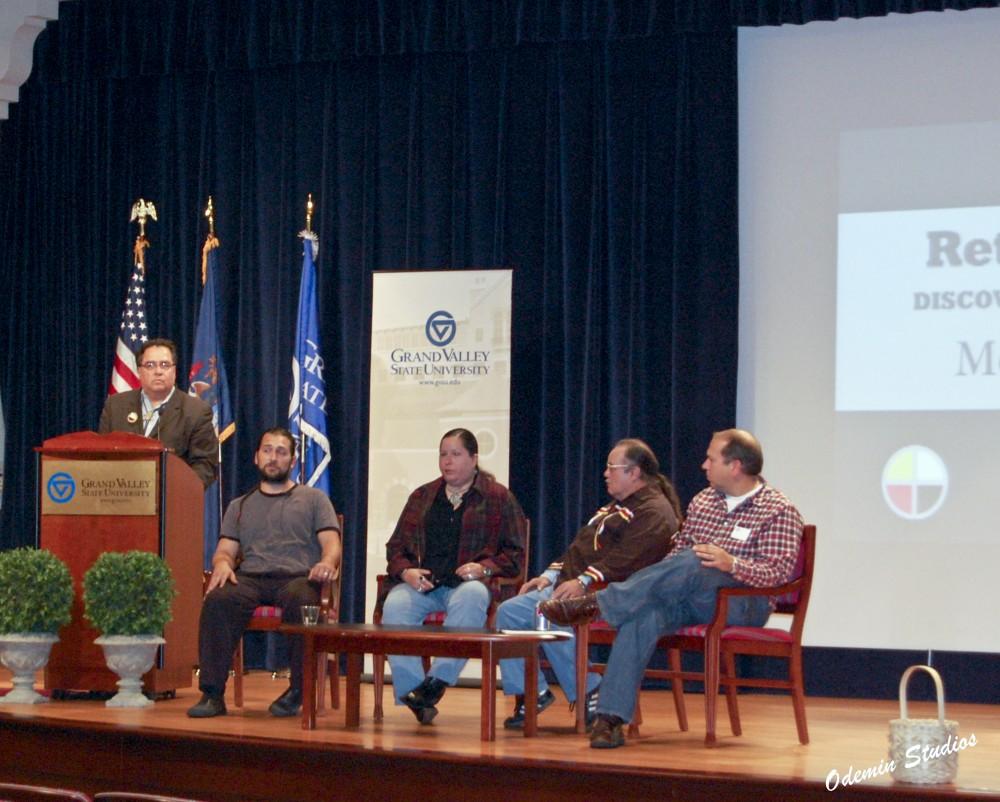‘Rethinking Columbus’ gives students a different perspective

Courtesy Photo / Amy Boyd The panel discusses topics about Columbus during the Rethinking Columbus event
Oct 17, 2010
The rhythmic beat of the Indian drummers drowned out the usual noon sounds of the DeVos Center clock tower. Crowds of curious students were drawn to the Loosemore Auditorium by the bellowing chants of the natives as a group of 35-50 students, faculty and community members answered the call of their cause.
The Grand Valley State University Native American Student Association combined with other organizations to present “Rethinking Columbus: Discover the American Indian Perspective” last week to give the general public a different viewpoint of the day.
“Columbus Day is a misrepresentation of history,” said drummer Jonathan Reinhart.
This message of a non-traditional Columbus Day event was communicated throughout the program by incorporating humor, theater and music, but the crowd appeared at the event somber and serious, perhaps due to the seriousness of the subject.
To begin, the audience was showed a 1960s cartoon from Mel-toons, which displayed a false depiction of Columbus as a hero discovering America.
Dee Ann Sherwood, from the office of Inclusion and Equity, explained that the film showed what we learned in school all the way through high school.
“It showed the indoctrination and cultural mythology that we teach American students,” she said.
After the cartoon, a video presentation showed clips of media entities such as Katie Couric glancing over the perspectives of Native Americans.
The segments then moved into visuals of American Indian protesters being hosed and jailed by the authorities for trying to tell their stories.
“We often idolize Columbus as a great explorer,” said GVSU student Lindsey Foster. “Instead, Columbus committed crimes and the day honoring him has been distorted over the years, covering up the real story of first contact.”
The theatrical portion explored this point with humor in an opening song called “Mother.” The song was just vocals with no words accompanied by drums, which showed that the indigenous people were content with their way of life before the Columbus’ arrival.
Once the “discoverers” arrived, the actors portrayed the crew as erroneously believing they had arrived in India and thus naming the “animals” Indians.
The crowd broke out in laughter as the “Indians” pulled out a cell phone, calling Homeland Security on Columbus and his crew.
“The play was designed to humorously connect the past with the present and show how our culture, language and tradition were stolen,” Sherwood said.
The play concurrently showed facts on screen, such as the initial Arawak population estimate of 8 million before Columbus arrived. By 1516, only 12,000 were still alive. By 1542, less than 200 remained, and by 1555 the Arawaks were all gone.
The hour-long presentation ended in a discussion panel where a facilitator asked area Indian leaders and educators related questions.
“How does this ugly past of genocide affect the present?” asked Levi Rickert, of the Prairie Band Potawatomi nation.
Shannon Martin, director of Ziibiwing Center in Mount Pleasant, Mich., answered, “If we don’t learn from the past, it still will be perpetuated; it’s not gold and spices now, but oil.”





















